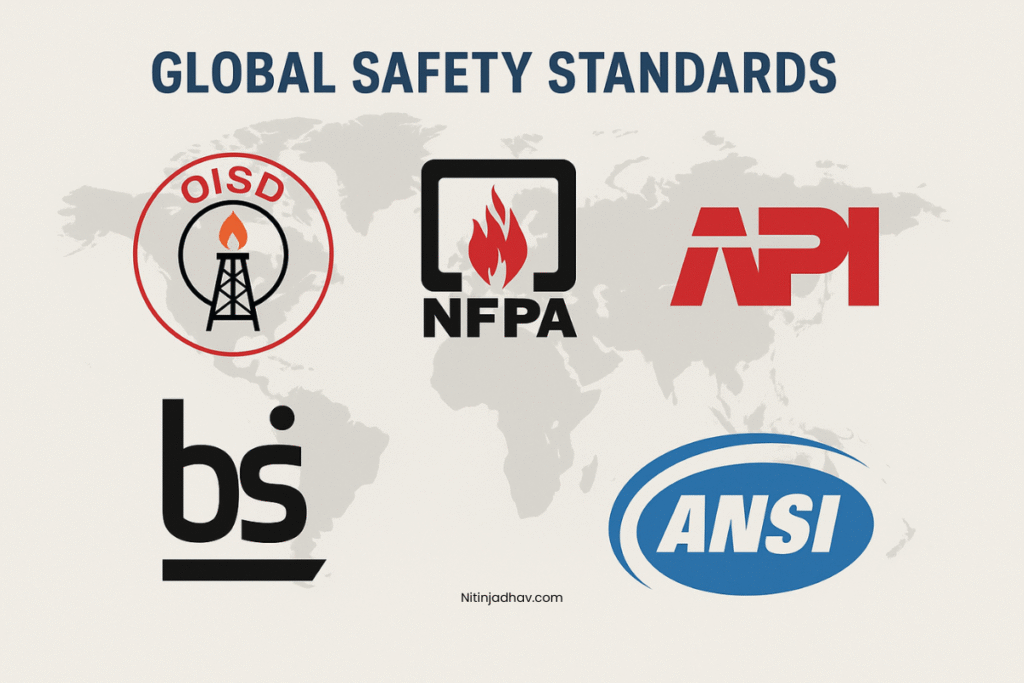Introduction
In high-risk industries such as oil & gas, petrochemicals, and chemical manufacturing, ensuring safety is not just a regulatory requirement—it’s a responsibility. Process Safety Studies are structured analyses used to identify, evaluate, and mitigate risks in chemical processes throughout a project’s life cycle—from conceptual design to operation.
This article provides a comprehensive list of key process safety studies, categorized by project phase, with brief descriptions and practical insights. Whether you are a Process Engineer, HSE Specialist, or a Loss Prevention expert, this guide will serve as your quick reference and checklist.
Why Process Safety Studies Are Important
Process Safety Studies help:
- Prevent catastrophic events (fires, explosions, toxic releases)
- Ensure regulatory compliance (OISD, OSHA, API, NFPA, CCPS)
- Reduce operational downtime
- Improve reliability and plant integrity
- Safeguard life, environment, and assets
👉 Read more: Fire and Gas Detection Philosophy – Basics for Engineers
🔹 1. Feasibility & Conceptual Phase Studies
| Study Name | Purpose |
|---|---|
| Inherent Safety Review (ISR) | Identify design options that eliminate or reduce hazards at source |
| Hazard Identification (HAZID) | Preliminary identification of major hazards and risk areas |
| Plot Plan Safety Review | Evaluate safe layout and segregation of hazardous units |
🔹 2. Design & Detailed Engineering Phase Studies
| Study Name | Purpose |
|---|---|
| Quantitative Risk Assessment (QRA) | Quantify individual and societal risk using consequence & frequency analysis |
| Consequence Modeling | Analyze worst-case release scenarios (Jet fire, Explosion, Dispersion, etc.) |
| Explosion Risk Analysis (ERA) | Evaluate explosion overpressures and vulnerability zones |
| Fire Protection Adequacy Study | Ensure design meets minimum fire protection requirements |
| Gas Dispersion Analysis | Simulate flammable/toxic gas release and dispersion distances |
| Emergency Escape Route Analysis (EERA) | Validate safe evacuation paths for personnel |
| Firewater Demand Calculation | Determine required flow rate for firefighting |
| Hazardous Area Classification (HAC) | Classify zones for electrical equipment based on flammable atmospheres |
👉 Explore more tools: Online Firewater Demand Calculator
🔹 3. Construction & Pre-Commissioning Phase Studies
| Study Name | Purpose |
|---|---|
| Pre-Startup Safety Review (PSSR) | Final check before startup to confirm all safety systems are in place |
| Constructability Review | Ensure design supports safe and efficient construction activities |
🔹 4. Operation & Maintenance Phase Studies
| Study Name | Purpose |
|---|---|
| Hazard and Operability Study (HAZOP) | Systematic review to identify deviations from design intent |
| Layer of Protection Analysis (LOPA) | Semi-quantitative risk analysis to evaluate need for Independent Protection Layers (IPLs) |
| Bow Tie Analysis | Visual risk analysis to identify causes, consequences, and barriers |
| Job Safety Analysis (JSA) | Task-specific hazard analysis for routine/non-routine jobs |
| Facility Siting Study | Assess risks to occupied buildings near hazardous operations |
| Safety Integrity Level (SIL) Assessment | Determine required reliability of safety instrumented functions |
| Operational Risk Assessment (ORA) | Used during temporary deviations or modifications in operations |
🔹 5. Asset Life Extension & Decommissioning Phase
| Study Name | Purpose |
|---|---|
| Integrity Operating Windows (IOW) | Define safe operating limits for aging assets |
| Decommissioning Risk Assessment | Identify risks related to safe dismantling and disposal of assets |
✅ Process Safety Study Matrix by Project Phase
| Project Phase | Relevant Studies |
|---|---|
| Feasibility | ISR, HAZID, Plot Plan Review |
| Design | QRA, ERA, HAC, HAZOP, SIL |
| Pre-Startup | PSSR, EERA |
| Operation | HAZOP, JSA, LOPA, Bow Tie |
| Asset Life Extension | IOW, Decommissioning Risk Study |
✍️ Final Thoughts
Understanding and implementing the right process safety study at the right time ensures that hazards are addressed proactively, not reactively. For professionals and organizations aiming to build a robust process safety culture, this checklist is indispensable.
📌 Bookmark this page or share it with your engineering team and clients!
👉 Related Reads on NitinJadhav.com:


